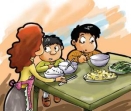

初中英语人教新目标 (Go for it) 版九年级全册Section B优秀第3课时教案
展开UNIT 10 You’re supposed to shake hands.
Section B (1a-1d) 第3课时
设计说明 本课时通过一些图片引入同学们对餐桌礼仪的讨论, 让同学们用前一课时学过的be supposed to do sth. 来描述图片; 接着处理教材1a内容, 同时拓展中国的餐桌礼仪问题; 再通过1b, 1c部分练习同学们的听力, 并练习对话朗读和角色扮演, 同时通过对听力材料的挖掘, 锻炼同学们从对话中提取信息的能力; 之后以小组形式对我国的其他餐桌礼仪进行讨论形成对话, 并在课堂上展示。最后通过习题检测学生的学习效果。 教学目标 通过本课时的学习, 让学生达成以下目标: 1. 知识目标 be supposed to do sth. 的运用。 2. 能力目标 (1) 运用be supposed to do sth. 描述各国餐桌礼仪。 (2) 听取录音具体信息并做记录。 3. 情感目标 通过学习, 了解世界各国餐桌礼仪, 培养礼仪意识。 重点难点 重点: be supposed to do sth. 的运用 难点: 听取录音具体信息并做记录 教学准备 PPT课件; 1b, 1c的录音 授课时数 1课时 教学过程 Step 1 Lead-in 1. Talk about table manners around the world with students. T: There are many table manners around the world. But different countries have different culture… 2. Show some pictures about table manners and then ask students to speak the table manners in most Asian countries using “You are (not) supposed to…”.
Step 2 Speaking 1. Ask students to take the quiz in 1a by themselves. 2. Check the answers. And correct the wrong sentence together. Answers:
3. Show some pictures of Chinese table manners, and ask students to say they are true or false.
Answers: √ × × × × × 4. Ask students to say what they should/shouldn’t do on table using “We should/shouldn’t…” or “We are (not) supposed to…”. Step 3 Listening 1. Ask the students to look at the pictures in 1b first and then guess what they will hear. 2. Play the recording and ask students to listen and number the pictures in the order they hear them. 3. Check the answers. Answers:
4. Ask students to listen to the recording again and match the sentence parts in 1c. 5. Check the answers. And then ask students to read the sentences aloud at least three times. Answers:
6. Ask students to listen to the recording again and complete the following questions. (1) How does Steve feel about leaving for China? A. Excited and sad. B. Happy and afraid. C. Excited and nervous. (2) Which of the following is not right? A. It’s impolite to stick your chopsticks into your food. B. It’s impolite to point at anyone with your chopsticks. C. Children are not allowed to speak at the table. (3) In the United States, children aren’t supposed to start eating first if there are older people at the table. Is it true? A. Yes, it is. B. No, it isn’t. C. We don’t know. Answers: (1) C (2) C (3) B Step 4 Learn about the tapescripts 1. Ask students to read the tapescript after the recording once and then read them by themselves. Pay attention to the differences between China and America on table manners. 2. Ask students to role play the dialogue. Tapescript: Yang Ming: You must be excited about leaving for China tomorrow, Steve! Steve: Yeah, but I’m a little nervous, too. Yang Ming: Why? Steve: Well, for one thing, I don’t know how to use chopsticks very well… and I don’t know how to behave at the dinner table. Yang Ming: Oh, I see. Well, one important thing is that you’re not supposed to start eating first if there are older people at the table. Steve: That’s interesting. In the United States, it doesn’t matter. Yang Ming: Yeah, I know. It’s also impolite to stick your chopsticks into your food. You shouldn’t point at anyone with your chopsticks, either. Steve: Oh, OK. Yang Ming: Oh, and there’s one more thing you need to know. You’re not supposed to talk when you’re eating dinner. Only parents are expected to talk at the dinner table. Children are not allowed to speak. Steve: Wow! That’s… that’s unusual! Yang Ming: Haha, I’m just kidding! 3. Ask students to complete the following chart with the help of the tapescripts and check their answers.
Step 5 Talking 1. Ask students to talk about other table manners in our country in groups. 2. Show the talk in front of the class in groups. For example: A: We are supposed to… B: Yes, and it’s impolite to… Step 6 Summary Get the students to have a summary about important language items. 1. Sentences: We should/shouldn’t… We are (not) supposed to… It’s polite/impolite to… 2. Phrases: 把你的筷子插进食物里 stick your chopsticks into the food 用你的筷子敲空碗 use your chopsticks to hit an empty bowl 用你的筷子指着任何人 point at anyone with your chopsticks Step 7 Homework 1. Write a passage about Chinese table manners. 2. Preview the article on page 78. 板书设计
|
初中英语人教新目标 (Go for it) 版九年级全册Section B精品第3课时教案及反思: 这是一份初中英语人教新目标 (Go for it) 版九年级全册Section B精品第3课时教案及反思,共5页。
初中英语人教新目标 (Go for it) 版九年级全册Section B优质第3课时教案设计: 这是一份初中英语人教新目标 (Go for it) 版九年级全册Section B优质第3课时教案设计,共4页。
2021学年Section B精品第3课时教学设计: 这是一份2021学年Section B精品第3课时教学设计,共4页。教案主要包含了语法提要,问题探究等内容,欢迎下载使用。

























